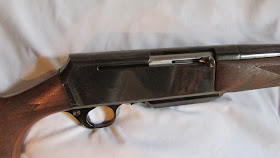There has been a trend among Cowboy Action shooters/enthusiasts for a few years now to "antique" the finish of their guns.
I'm not sure why you would want your 2 year old Ruger Vaquero to look like a 102 year old Colt, but different strokes right?
I guess this is similar to the AK-47 owners making their guns appear to be "Battlefield Pick-ups"
or the rat rod scene within the Hot Rodding world.
For reference here is a genuine 100+ year old Colt Single Action Army (circa 1875):
And here is a new Ruger Vaquero that has been artificially "aged":
Uberti offers a factory antiqued finish, they call it the "Old West" finish
USFA once offered the same finish on their "Gunslinger" model
Beretta offers something similar
My Father has an Uberti Hombre (like the one below) with a rough finish, that I think is supposed to wear into an antiqued finish? I never did understand why it came with this finish (ever see a Colt that looked like this?)....perhaps now I know why....
This is what an antiqued Hombre looks like, much more authentic looking in my opinion.
 Boge Quinn from GunBlast aged this Uberti Gunfighter SAA clone using ScotchBrite pads to soften the surface and tea to darken the stag grips. See his write up here:
Boge Quinn from GunBlast aged this Uberti Gunfighter SAA clone using ScotchBrite pads to soften the surface and tea to darken the stag grips. See his write up here:
Here is where I get confused.....Cowboy Action Shooters
dress up like the people did in the 1880s, they recreate shootouts in
ranges made to look like a town from the 1880s, then (some of them) make their
guns looks like they were found in a barn in the 1980s???......certainly a Colt
Single Action Army made in 1873 would not look 100 years old in 1880, it would look
more like 7 years old, would it not?
I understand the
old west was hard on equipment and tools, and guns were considered just
that: tools. People used them and didn't always have the means to
properly care for and store a gun. I'm not sure though that the guns
would get that "ratty" looking in that short amount of time.
No matter which way you look at it, this is an interesting facet of gun collecting.
here are a few more, remember these are modern guns made to look old, some of them do look to be 100+ years old....
I know some of you thought you were expecting to see a restoration of a M1918 BAR.
Sorry to disappoint you, this restoration involves a Browning Automatic Rifle High-Power series. This is the sporting rifle created by the grandson of John Moses Browning: Bruce Warren Browning along with Marcel Olinger.
The sporting BAR was introduced by Browning Arms in 1967 and was produced in FN's Belgium plant.
This particular gun was a grade 1, it has none of the engraving that was common with higher grade Brownings.
According to Browning's website this particular gun was built in the 3rd year of production in 1969. You can check your serial number here.
I had two concerns in taking on this restoration:
1. The quality finish on FN's Browning guns is superb, I didn't feel comfortable that I could reproduce the results of the Herstal factory.
2. The dreaded "salted wood problem". If this gun is cursed with salted wood, there may be little if anything that I could do within the limited budget to clean up the gun.
If you know anything about Browning rifles & shotguns, you probably know about the "salted wood" problem.
In the mid 1960's Browning had trouble finding dried & stabilized walnut for their stocks. They had found a supply of fresh walnut from California, but they needed to dry them fast. Some "genius" decided to use a salt curing process.
Basically the stack of walnut planks were buried in salt. The salt leached out the moisture in the wood. That is all fine and dandy, the problem occurred when the water that leached out of the walnut on the top of the stack mixed with the salt and created a brine solution that then soaked into the wood in the middle and bottom of the stack.This wasn't noticed until years later when the salt began leaching from the wood causing the metal to rust on the rifles and shotguns. Supposedly this problem appeared on about 90% of the guns made during the 1966-1970 era (the 10% not affected must have been from the top of the stack?). By late 1969 the problem had been discovered and steps were made to prevent the rusting. Although some guns built as late as 1972 and even into the 1980s have the problem.
Here are the pictures of the gun when it arrived. Although it had rusty sling swivels and minor surface pitting, it showed no other signs of being a "salted rifle". I wont know for sure until I take it apart.
There is some strange green stuff stuck in the checkering of the fore stock.....gum? Silly Dough? booger?
Even with the freckling you can see my reflection in the side of the receiver. This is the worst of the rust.
Stay tuned for Part 2
References
Art's Gun Shop


















.jpg_thumbnail0.jpg)






























